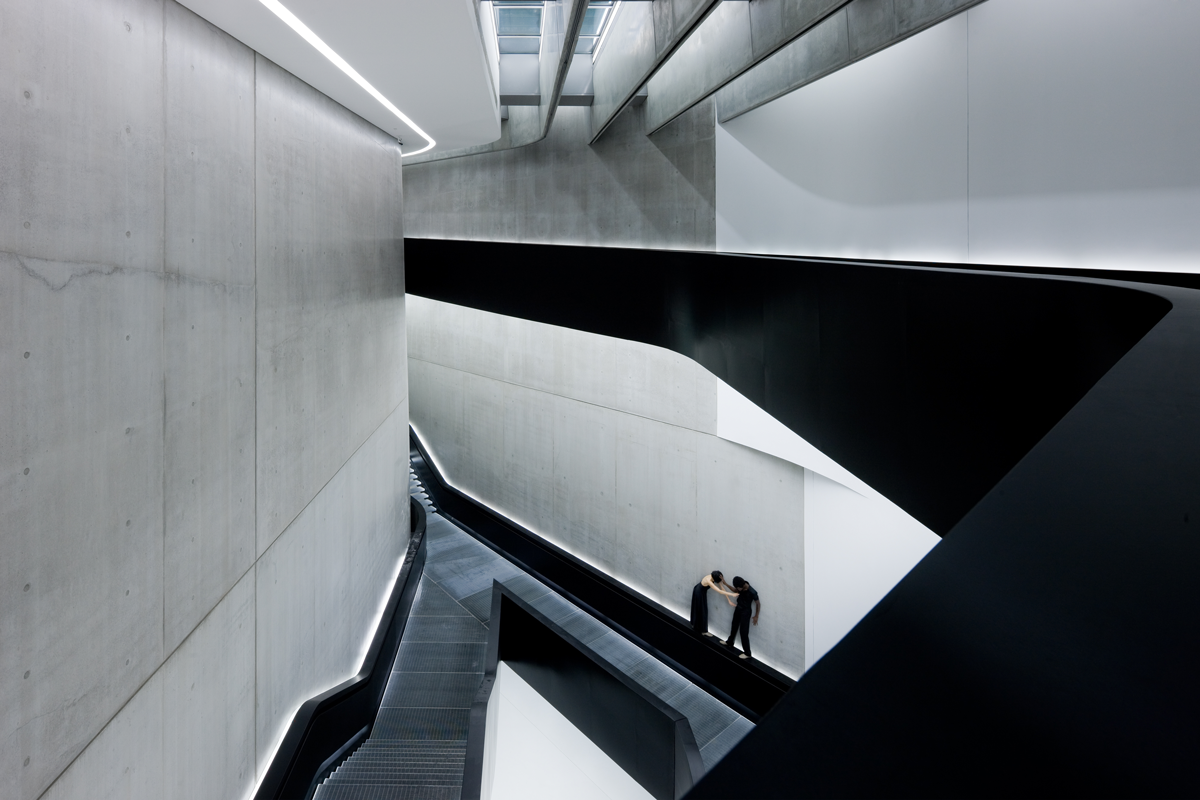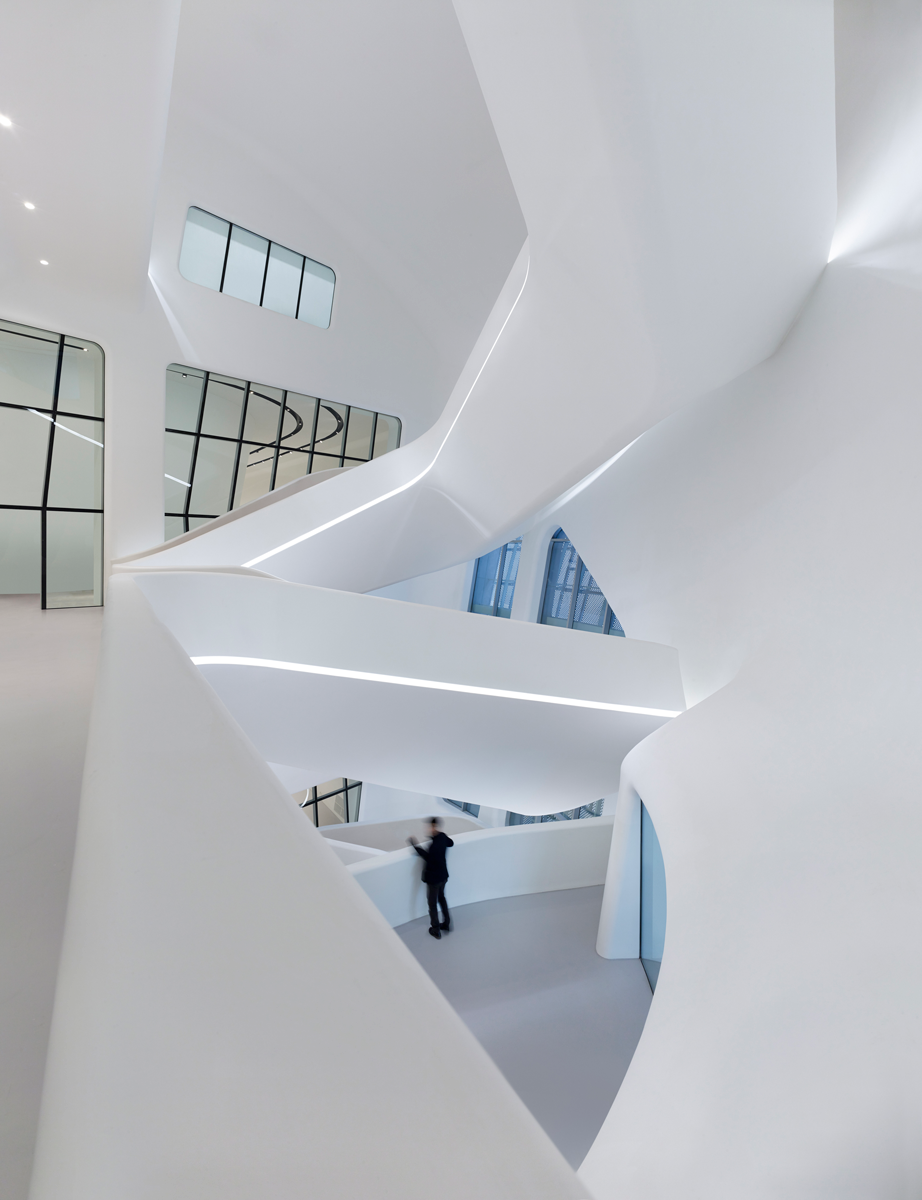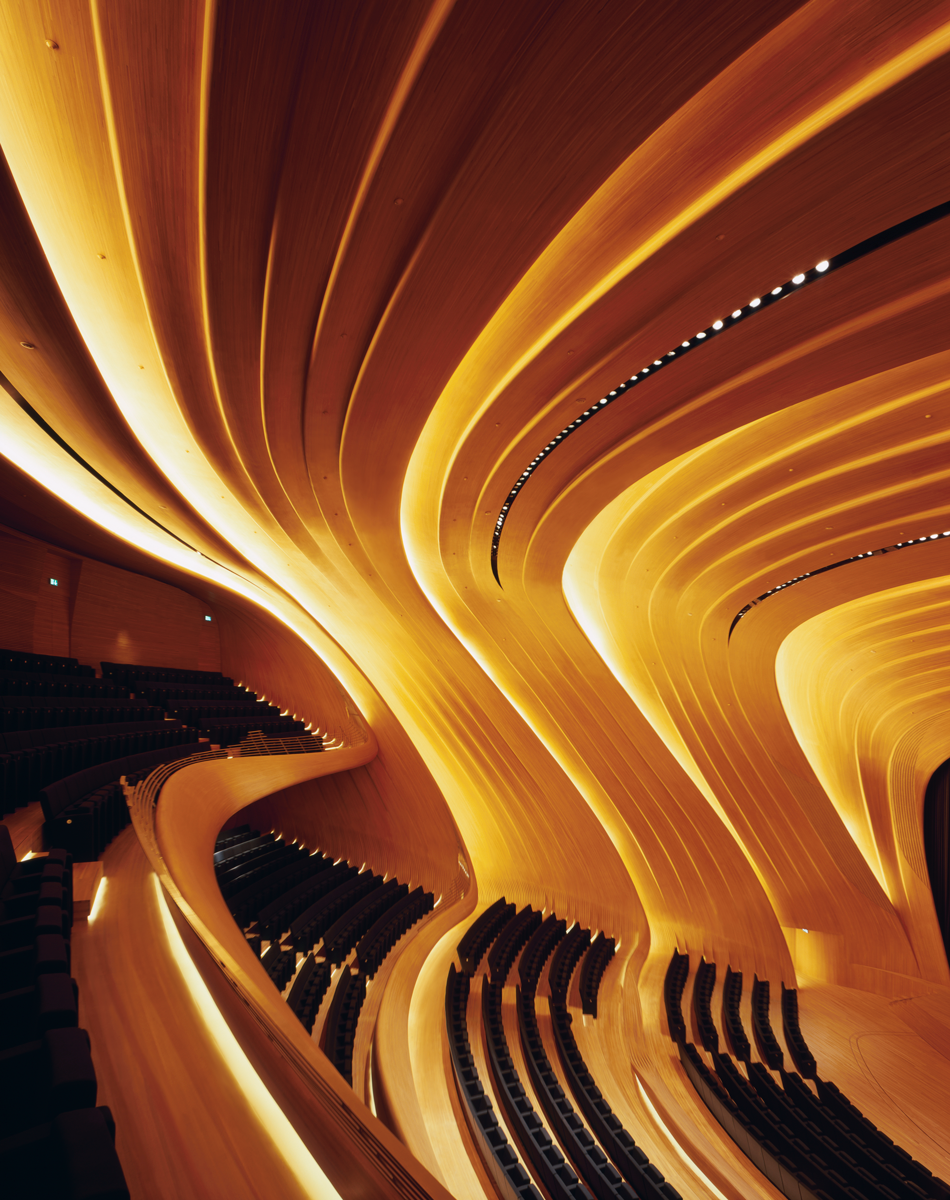
MAXXI Museum, Rome, (2010). Photo: Iwan Baan.

Dongdaemun Design Plaza, Seoul, (2014). Photo: Virgile Simon Bertrand.

Heydar Aliyev Center, Baku, (2010). Photo: Helene Binet.
[](#)[](#)
Zaha Hadid
“They Used to Tap Me on the Shoulder and Say ‘You Are OK for a Girl’”\*
**“Not everybody can travel around the world to see the great works of architecture and art, and archaeological ruins. But museums, libraries, and cultural centers can bring this experience to every city.” – Zaha Hadid**
Like the studies and sketches developed by Leonardo da Vinci for flying machinesi, some of the designs created by London-based Zaha Hadid—from painted cities that speed across canvas skies, to works of architecture that seem to float on waves of light—present visions of the future that will echo through the ages.
Named “Designer of the Year” at the inaugural Design Miami, Ms. Hadid has been shuttling between that city and her London studio exhibiting her cutting-edge canvases, and guiding the construction of the 1000 Museumii, a new Miami tower that is rising opposite Museum Park.
She recalls in an interview that her intertwined lives in art and architecture were sparked while she was enrolled in London’s Architectural Association School of Architecture, whilst becoming mesmerized by paintings of Kazimir Malevich—the spearhead of the Suprematist art revolution launched in Russia a century ago. At the same time that Albert Einstein reimagined the world of classical physics with his Theory of General Relativity in 1915, Malevich and his contemporaries began depicting unusual arrangements of geometry, with paintings such as his 1915 work: “Two dimensionaliii painted masses in the state of movement.”
When Hadid discovered Malevich’s breakthroughs in abstract art decades later she immediately saw the potential not just for artists, but also architects, who could throw off countless centuries of tradition in favor of pure creativity. Exploring the planes of color that drift through Malevich’s artworks, she perceived floating worlds that could be read as blueprints for structures that break free from the force of gravity.
Hadid began painting these visions in works like The Peakiv series, which helped her win first place in an international competition to design The Peak Club on a mountaintop overlooking the Hong Kong Harbor.
Since then—as her paintings have entered the permanent collections of Manhattan’s Museum of Modern Art and San Francisco’s MoMA—Zaha Hadid has built structures that appear to hover on beams of light. Her Suprematist-inspired Vitra Fire Station in Germany seems poised to take wing, while the Guangzhou Opera House resembles a crystalline space capsule, and the building slabs that combine to form Italy’s new Messner Mountain Museum—like those in The Peak paintings—seem frozen in a trajectory that emanates from the geological formations surrounding it.
Hadid helped transform a gunpowder magazine constructed in London during the Napoleonic Warsv, into the Serpentine Sackler Gallery. “The future was invented on the fragments of the past,” says the Serpentine’s co-director, Hans-Ulrich Obrist, who commissioned Hadid to design the project. The gallery’s restaurant—sitting under a flowing canopy supported by sculptural steel columns—has been described by the UK’s Sunday Times as “one of the most [inspiringly beautiful dining rooms in London, in Europe, in the world.”\*.1](http://www.thesundaytimes.co.uk/sto/Magazine/article1345134.ece)
The design of the Heydar Aliyev Center—an art gallery and auditorium in Baku, Azerbaijan, and recipient of 2014’s Design Museum’s Design of the Year Award—was built over the site of a Soviet tank factory. While in Rome, Zaha Hadid Architects transmuted an abandoned army outpost into the MAXXI museum for art and architecture. Time and again, Hadid has given a place an entirely new explosive quality. What was it like to build a work of experimental architecture in the Eternal Cityvi of Rome?
“Rome is a great city,” Hadid explains. “Although it is very modern, MAXXI looks like it has grown out of the context… Cities in ancient times were not preserved, they were built on top of each other, and they look amazing. This design shows avant-garde architecture can blend with ancient civilization.”
In 2010 Hadid was designated a UNESCO Artist for Peace. UNESCO Director-General Irina Bokova praised Ms. Hadid for “her efforts to raise public awareness of intercultural dialogue, to promote excellence in design and creativity, and her dedication to the ideals and aims of the Organization.”
Hadid says that a primary aim in her studio’s design of cultural outposts in China, Azerbaijan, Italy, and France is to blur divides between diverse sectors of the populace. “It is essential to create these cultural spaces that unite the city—they tie the urban fabric together,” she explains. “By the very nature of their cultural importance, these projects are accessible to everybody, eliminating segregation and division.”
These arts oasesvii are intended as beacons that can illuminate and spark new life across an entire city or culture. “More and more around the world, people want to go and have some culture time,” she explains. “What makes a metropolis is to have these cultural buildings.
“Not everybody can travel around the world to see the great works of architecture and art, and archaeological ruins. But museums, libraries, and cultural centers can bring this experience to every city,” Hadid says. “By populating the city with these programs, you enliven the city.”
While Hadid has pushed forward the Suprematist art movement across her canvases, Thomas Krens, the former Director of the Solomon R. Guggenheim Foundation (who commissioned an exhibition of her work at the Guggenheim Museum in New York in 2006), adds in an interview, that she simultaneously leads today’s “technological renaissance” in architecture. On the global stage, her firm has been in the vanguard of computational design, which builds on leading-edge techniques developed for digital animation.
Her studio’s work in computational design and precision fabrication has extended to sculpture-like fashion, and to furniture. Earlier this year, at a Milan Design Week showcase, Zaha Hadid in a partnership with United Nude, unveiled Flames, a 3D-printed stilettoviii. Following another footwear collaboration with Pharrell Williams for Adidas, the singer-songwriter commented in a video posted on YouTube that: “I think Zaha’s designs are just like her buildings—they augment reality forever.”
Hadid’s recently applied her futuristic fabrication techniques to the Liquid Glacial collection of sculpted tables and centerpieces, the likes of which you’ll experience on this issue’s cover of _Flaunt_. Miniature maelstroms swirl across these pieces, creating revolving kaleidoscopes of color and the illusion that the water patterns have never frozen solid.
In these fluid formed tables presented in collaboration with David Gill Gallery, Hadid uses reflection and refraction to skillfully play with light. Reflected light is similarly a medium in the new Middle East Center at Oxford University, where the stainless steel façade appears to dissolve the building into its context, with impressionistic images of surrounding trees and skies gliding across the surface of the structure.
Fluid geometry similarly inspired her designs for the London 2012 Olympics Aquatics Center, and will again for another aquatic center that will cap the 66-story 1000 Museum project in Miami.
1000 Museum is just one of Ms. Hadid’s highly anticipated projects in the US: her studio is simultaneously constructing the 520 West 28th Street complex in Manhattan, adjacent to the new High Line elevated park and arts enclave. In renderings for the studio’s Manhattan projectix, Zaha Hadid’s Suprematist paintings are sprinkled across the interiors, creating the impression that each space is also a pop-up gallery. Just about any of Hadid’s creations could be said to have that fresh, dynamic, pop-up quality, though some will live for a far longer time, futuristic visions that will cut through the curving spans of time.
#### Editor’s Footnotes:
**i** _Leonardo da Vinci designed numerous flying machines, though there’s no evidence that any were ever built, and it’s questionable whether any of them would have ever flown. Renaissance man Harrison Ford has been in two plane crashes and a helicopter crash. A (somewhat) skilled pilot, Ford is regularly involved in assisting the Teton County Search and Rescue. Upon rescuing a lost hiker in 2007, the woman boarded Ford’s personal helicopter and vomited in a hat. “I can’t believe I barfed in [Harrison Ford’s helicopter!”\*](http://abcnews.go.com/Entertainment/story?id=116341)_[.2](http://abcnews.go.com/Entertainment/story?id=116341) _she later remarked._
**ii** _In 2014 the_ Washington Post _pointed out that [there are more museums in the country (35,000) than there are Starbucks (11,000) and McDonalds (14,000)](https://www.washingtonpost.com/news/wonk/wp/2014/06/13/there-are-more-museums-in-the-us-than-there-are-starbucks-and-mcdonalds-combined/)_ _[combined.](https://www.washingtonpost.com/news/wonk/wp/2014/06/13/there-are-more-museums-in-the-us-than-there-are-starbucks-and-mcdonalds-combined/)\*_.3
**iii** _The Einstein field equations that underpin General Relativity express spacetime as a 4-dimensional Lorentzian manifold that incorporates the dimensions up and down, back and forth, side to side, and time, with time being a special case where the causal structure is distinct from the other dimensions—eg. time don’t go backwards. In 2004, film reviewer Ryan Ellis (not to be confused with_ Flaunt _Deputy Editor E. Ryan Ellis) described Matthew McConaughey’s performance in_ How to Lose a Guy in 10 Days _as “one-dimensional.” In 2014 many reviewers speculated that in_ Interstellar _Matthew McConaughey entered the fifth dimension._
**iv** _The Hong Kong Peak receives seven million visitors annually. Its peak period is all year round._
**v** _Known for being a short fellow that liked a bit of conquest, Napoleon was also the driving force behind canned food. Understanding that an army marches on its stomach, Napoleon offered a 12,000 franc prize for an inventor that could keep his army’s belly in the field. Nicolas Appert claimed the prize by devising a system for food to be heated and sealed in airtight glass jars. Tin cans were not in favor until the can opener was invented about 45 years later in 1855._
**vi** _Rome was sacked in 390 BC, and 410, 455, 546, 1084, and 1527 AD. Napoleon annexed the city in 1797, and Mussolini marched on it in 1922. The Nazis occupied it from 1943 until they were defeated in June 1944. Italian group Eiffel 65 released their smash hit “Blue (Da Ba Dee)” in 1999._
**vii** _One of the world’s most remote oases was at Ténéré in the Sahara Desert in Niger. There in the midst of an endless sandy expanse stood the Ténéré Tree—a lone acacia, and the only tree for over 250 miles. It was believed to have stood for hundreds of years, before being knocked down by a drunken Libyan truck driver in 1973. The driver is said to have remarked: “Today is gonna be the day that they’re gonna throw it back to you.”_
**viii** _The stiletto takes its name from the Roman stilus, the writing instrument used to inscribe wax tablets. In the late 15th century the “stiletto” was a needle pointed dagger used by Italian knights. Stiletto heels were first made by Andre Perugia in 1906, though were not called a stiletto in print until a_ New Statesman _article in 1959. Imelda Marcos is believed to have collected 1200 pairs of size 8.5 high-heeled shoes. Although the wife of the Philipino dictator General Marcos, she claims that her wealth came from discovered Japanese war loot._
**ix** _During the Manhattan Project in 1944, to motivate the scientists working on developing the atomic bomb, an announcement would occasionally be made over the loud speaker at Los Alamos: “Will Werner Heisenberg please report to the director’s office.” Heisenberg was the legendary German genius known to be in the (perhaps unwilling) employ of the Nazis for the development of their bomb. He has gained popular notoriety as the alter ego of Walter White in_ Breaking Bad.
**\*** \[Official OMEGA YouTube channel\]. (October 2012). OMEGA Ladymatic presents CNN's Leading Women - Zaha Hadid. Retrieved from [https://youtu.be/j2ZN5quZdfg](https://www.youtube.com/watch?v=j2ZN5quZdfg&feature=youtu.be)
**\*.1** [Gill, A. “Table Talk: Magazine, London W2,” Sunday Times, December 2013.](http://www.thesundaytimes.co.uk/sto/Magazine/article1345134.ece)
**\*.2** [“Action Star Harrison Ford Rescues Hiker,” ABC News.](http://abcnews.go.com/Entertainment/story?id=116341)
**\*.3** [Ingraham, C. “There are more museums in the U.S. than there are Starbucks and McDonalds – combined,” Washington Post, June 2014.](https://www.washingtonpost.com/news/wonk/wp/2014/06/13/there-are-more-museums-in-the-us-than-there-are-starbucks-and-mcdonalds-combined/)
